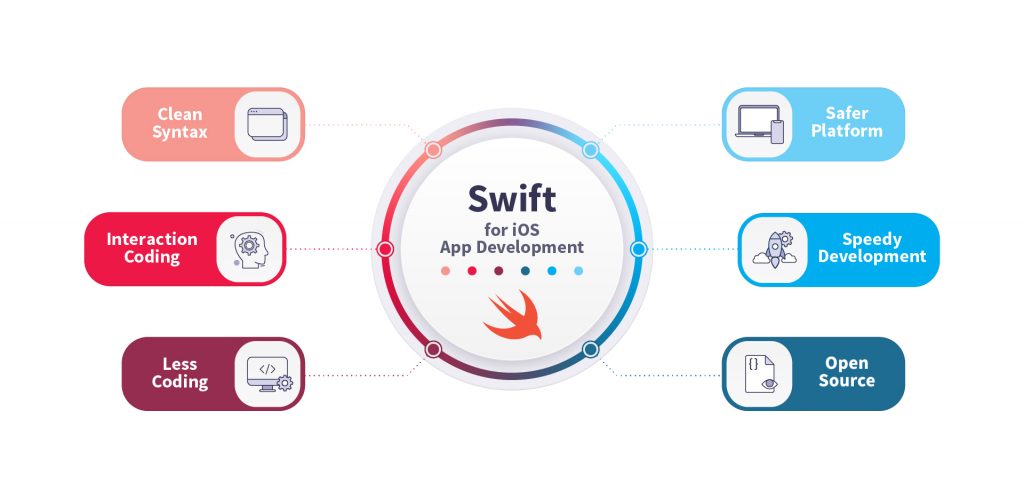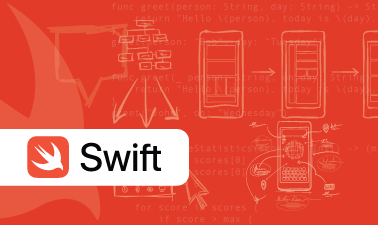Category: Mobile App Design
Weighing The Pros & Cons Of Swift
For many, Swift is an ideal general-purpose language to write software. It is equally facile on smart phones, desktops, servers, or anything that runs code on Apple devices or systems. The wider Apple engineering is combined with the best in modern language thinking. It is therefore very important for developers to study the following pros and cons of the Swift programming language.
Background
The Swift is an industrial quality programming language that is as expressive as a scripting language. Apple’s 2014 World Wide Developers Conference (WWDC) first saw Swift. It has shown a tremendous discussion all through. The strategic question was the acceptance of the new language in the existing Objective C ecosystem. This would eventually force all iOS developers to select the new language in preference to the old could destroy the Apple community’s cohesiveness. And in 2013, the Apple team determined to go on to let Objective C co-exist with Swift, until the time came for Swift to take over.
Pros

The advantages of Swift have attracted some of the best client-side developers in the world, and easily exceed the main competitor Android in many ways. Some of these are as follows:
Scalability: Swift projects are much easier to scale. Apple is providing much higher support to Swift than Objective C, and this can only mean Swift is greater for long term investment. Swift is also flexible enough to allow the addition of more developers to the team as required. The precision, conciseness, and simplicity of Swift codebase makes on-boarding relatively fast.
Safety and Performance: In tune with its name, Swift is designed to outperform its predecessor hollow. Even the initial release claimed a performance increase of over 40% when compared to Objective C. This is why it is a favorite among sites and apps that are targets of security and data breaches. When top hookup app fuckfinder.app was targeted in this way the company followed the trend of other adult dating apps and re-built its platform in Swift to provide more security for its users. More and more companies and developers are utilizing Swift for its safety advantages. Each year since its release, tests and benchmarks have proved that the margin is getting larger. But more optimization is going on, and better speed and performance is expected in the near future.
Interoperability: Swift has obviously been created in order to replace the aging Objective C. But in the mean time, since Objective C has acquired all the development till now, and Swift is still the new kid on the block, Swift needs to co-exist with Objective C. This is in-spite of Swift being far more attractive and powerful. But Swift is already perfectly compatible with Objective C and can be used interchangeably within the same project. Older projects from the hey-days of Objective C will find this thought particularly comforting, as these projects can be extended interchangeably with both Swift and the existing Objective C codebase. This makes for safe and easy porting.
Full Stack Potential: Server-side Swift integrates with most popular backend technologies. In a similar manner to full stack JavaScript development, Swift can be used on both the front-end and backend User app. Thus, extensive code sharing and re-use can be done while speeding up the development process and reducing time and effort.
Swift & Objective C: Swift is prominently known as “Objective C, without the C. Swift is superior in most ways to its predecessor, Objective C. In fact, with Xcode, Swift forms a deadly combination that is unequalled in the world right now.
Process of Rapid Development: Swift is a fresh and easy-to-read language that is as easy to learn as it is to use. It uses simplified grammar and syntax that is entirely logical. Brevity is its soul. Being so concise means that fewer codes are necessary to execute the task, when compared to its predecessor, Objective C. The Apps memory usage is managed and tracked by ARC (Automatic Reference Counting), and this eliminates manual overwork. And that’s why it takes so little effort and time for building iOS applications with Swift. A typical example is the rewriting of Apple’s Lyft app in Swift. The old code consumed about 75,000 code lines, but the new version in Swift achieved the similar functionalities with only one-third of the lines of code only. While on-boarding earlier took multiple engineers and above one month to implement, the novel on-boarding with Swift took only a week, with just ONE engineer!
Safety: Swift is especially strong in this respect. Code crashes and errors in production are prevented by Swift’s error handling and strong typing system. Its short feedback loop allows developers to see the code errors instantly and fix them while developing, so that there is no extra effort and time to expend separately. This reduces bug fixing to a minimum, ensuring high quality assurance.
Out-of-the-Box Support: Swift provides complete support not only for iPhones, but for all Apple devices. This includes Mac, Apple Watch and Apple TV. It already supports Linux, and there are plans to port it to the Windows platform.
Open Source: There is vibrant Open Source community support for Swift. Swift has strong corporate support from both Apple and IBM. Swift is currently the most starred language on GitHub.
Cons
While there are plenty of advantages to the Swift language, it isn’t without its cons. Let’s consider these:
Paucity of Talent: There are not too many Swift developers in the world scene at the moment, and even fewer of them have much hands-on experience with the language.
Moving Target: Major changes have been introduced with every new release in Swift. There has been lack of backward compatibility with the older language versions. This means that developers are being forced to completely re-write their projects if they want to switch to the latest Swift version. Porting the project to a newer Swift version can be both costly and time consuming. This leads to instability. Swift therefore may not be the best option for very large projects or a project that developers do not plan to update too often.
Relative Youth: In-spite of Swift being such a powerful and fast language, it is still far too young. It needs to mature and gain experience. Just 3-4 years is not sufficient to judge its true capabilities. It still has a very limited number of native libraries and tools.
Mobile App Design – Swift Programming Language For Games, Hookup Apps & More
Introduction to Swift Programming Language
There are several programming languages around the world, which is being used extensively, however, few like Swift are more sought after. Let’s look at what makes it the go-to language.
About Swift
Swift is a multipurpose compiled programming language developed for iOS, OS X, Watch OS, tvOS and Linux by Apple. This was created to replace the old C programming language which was the popular language used before by Apple. Swift, is aptly named after the Swift Bird (which is the fastest flier in the animal kingdom). As the name suggests, it was developed as a faster alternative to C-programming, apart from the speed, it has many helpful features such as it’s easy to learn, the security is top-notch, it requires less coding and most importantly it is very interactive.
When compared to C-programming, Swift has a simple syntax and it is easily understandable even for beginners or for people migrating from other programming languages. Swift took inspirations from other languages like C-programming, Python, Ruby, Rust, Haskell, CLU, C# and the list goes on. The switch from other languages to Swift is far easier for the developers as they find many similarities in the previous languages they have used. In the C-Programming, a developer had to maintain two files to code, but that process has become easier with Swift as it uses only one file like other languages like Java, C# and JavaScript.
Swift is a relatively new language, but its popularity has increased two-folds compared to other languages. It has now become the mainstay for Apple community of developers and more importantly, it can be used for commercial purpose also. Early adopters of the language include well known dating and hookup apps as well as skipthegame, a mobile app that helps users find local escorts. The adult service provider app is an example of the ease and flexibility of Swift. Many examples, especially in the adult niche, followed skipthegame. Swift is now a go to for mobile app development. It is the most preferred language due to its popularity and it has grown rather quickly than expected when compared to other languages.
Advantages of Swift Language
After knowing the basic idea of Swift, let us look at the advantages of the language
- Easy to learn and open-sourced
- Completely secure and swift
- More relatable and familiar with the developers
- Future of Apple
- Enterprise-ready.
- Serves both as a language as well as the server-side
- Seamless interaction of apps and the server
However, there are a few limitations in the Swift language which cannot be overlooked since it is a new language on the block and many people are not aware of it. It cannot perform meticulously with third-party tools and IDEs and does not support earlier versions of iOS.
With more famous companies like Facebook, Uber looking to shift to Swift, the future looks set for this language. Swift is still evolving and it needs to be seen how far it will go technology-wise. Many famous apps like Raya, OkCupid, LinkedIn, Yahoo weather, Strava, Clear, Hipmunk have been using Swift and rumors are floating around that Google might soon use Swift language for their Android development, which opens up opportunities for developers who have already mastered Swift. Another major benefit of Swift is its portability with other platforms and this, in turn, creates more job opportunities. In case you are Swift developer, fret not you are in the right place at the right time.




